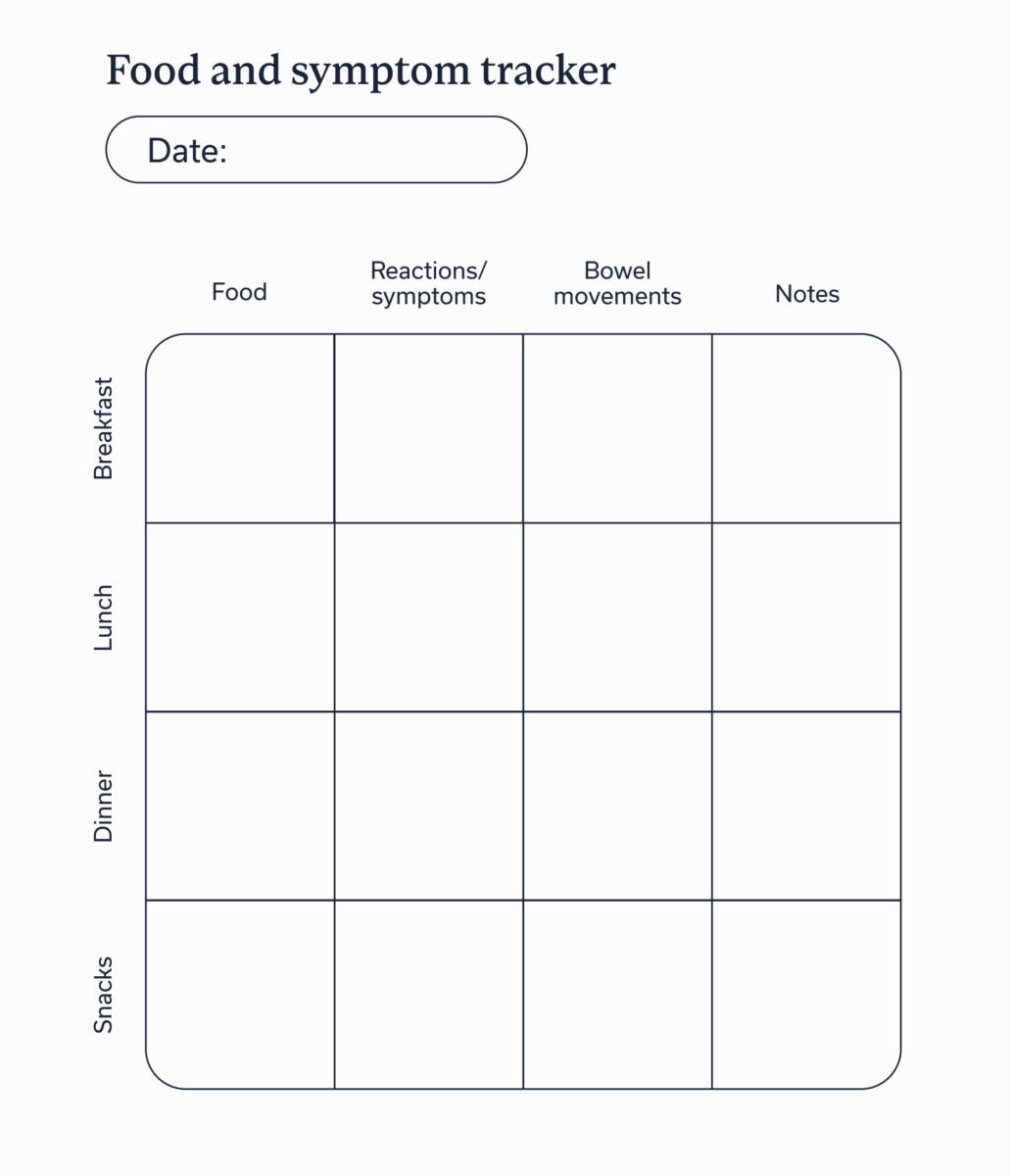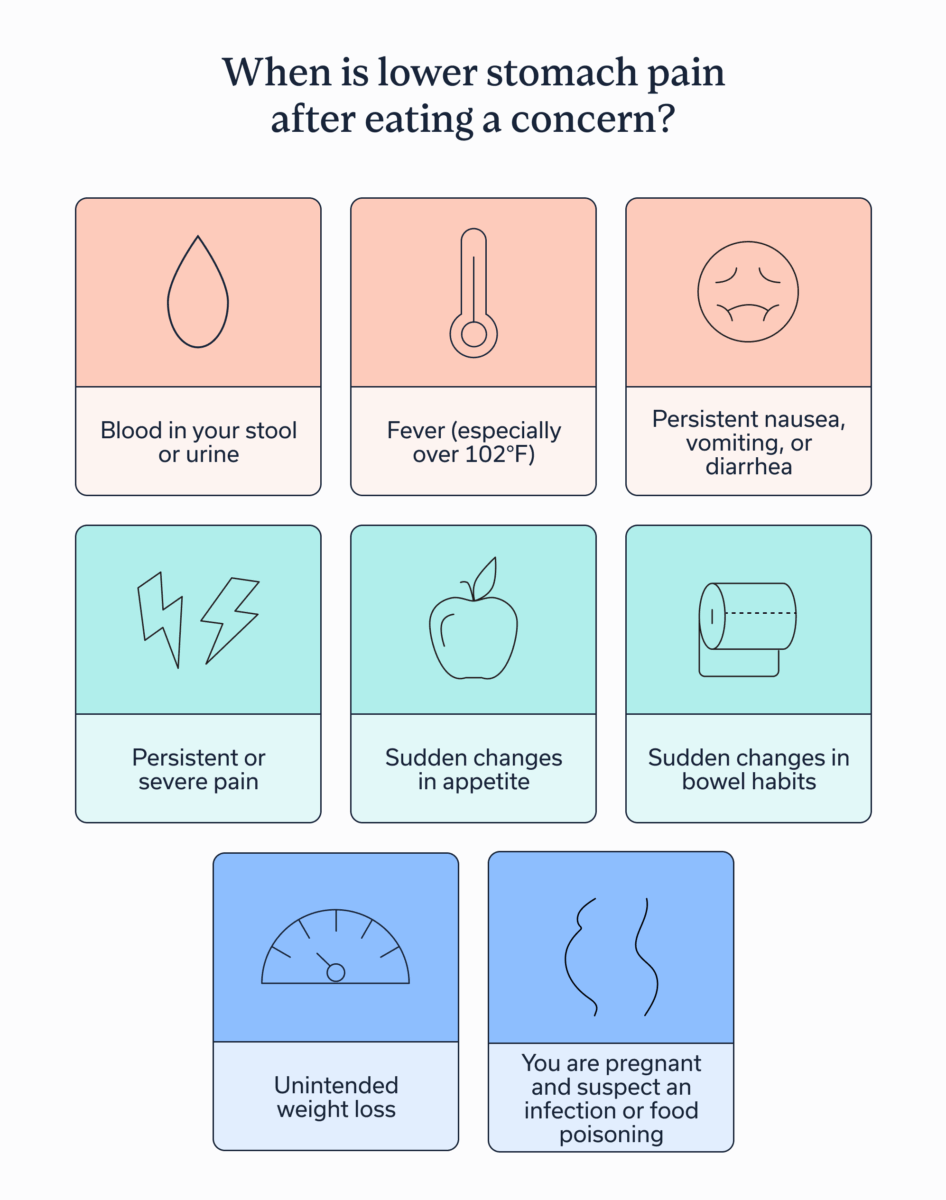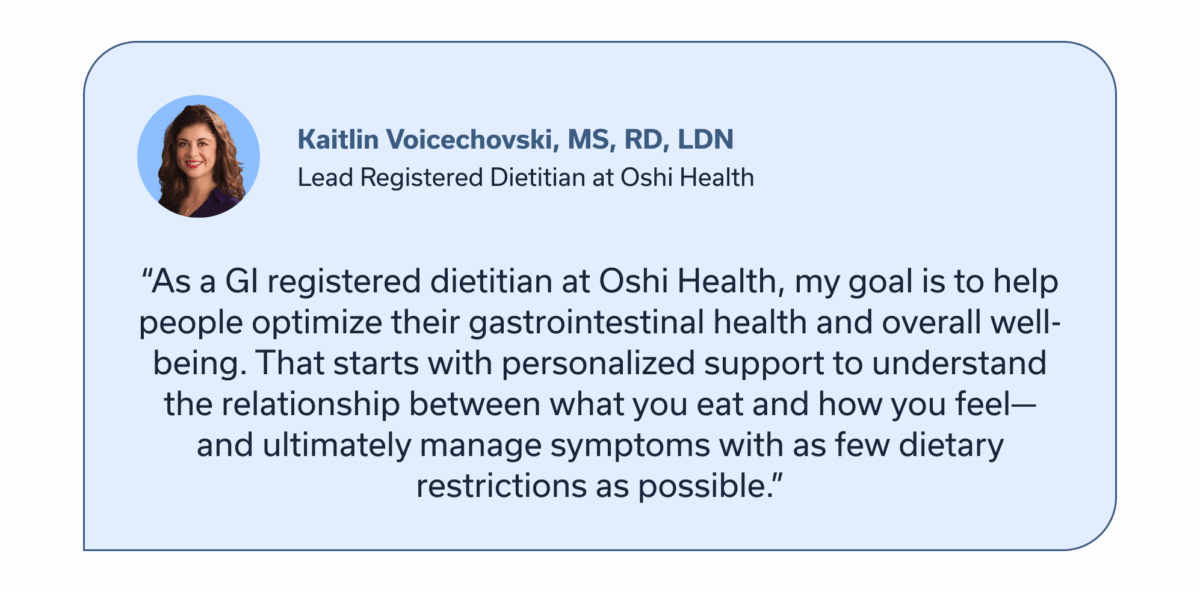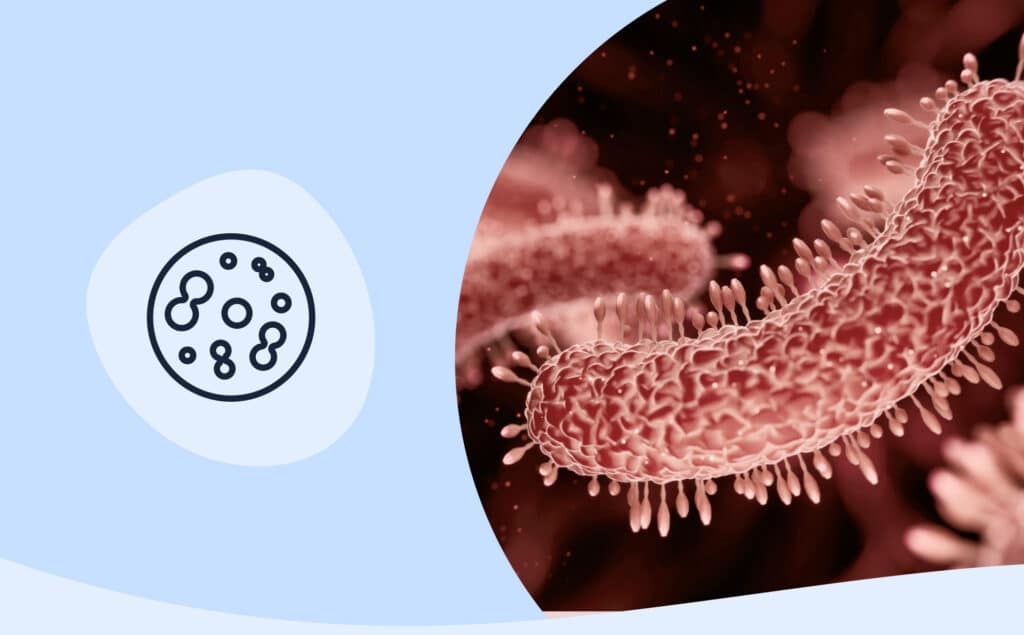When stomach pain and loose stool strike after eating, your alarm bells may be going off. What’s the reason behind the discomfort and diarrhea? It may simply be indigestion, but other reasons may include an infection (including food poisoning) or an underlying condition. Read on to learn some of the possibilities and what to do.
Eating your favorite foods can be a joyful and satisfying part of life when all goes well. But sometimes eating can bring about a stomachache or gastrointestinal (GI) symptoms, such as diarrhea—a not-so-joyful experience.
The occasional bout of abdominal discomfort is a normal part of life and could result from stress or anxiety or simply eating something that your system didn’t quite “agree” with. Maybe you experimented with a higher heat level on your favorite curry order, and your stomach is rebelling against your choice. Or maybe the extra side of beans with your taco salad is encouraging some extra gas production in your digestive system.
But if you regularly experience lower stomach pain after eating, talking to a healthcare provider is crucial. Ongoing GI symptoms could be a sign of a food intolerance or an underlying condition. Getting to the bottom of what’s bothering your stomach will help you get back to feeling better and enjoying eating again.
In this article, we explore common causes for abdominal pain after eating, remedies for easing GI discomfort, and when to see a provider.
Why does my stomach hurt after I eat? Common causes
A one-off incident of stomach pain after eating is generally not cause for concern, unless it’s severe. Here are a few possibilities that may be the source of your abdominal discomfort. But if symptoms persist, seeking medical attention is crucial.
You ate something that was “off” for you
The most obvious culprit might be that something you ate has caused temporary upset. This can happen if you eat a heavier meal than usual or you get a little too overzealous with a new spicy condiment or cream sauce, just to name a couple examples. In these cases, discomfort generally goes away within a few hours.
You have an infection
If your discomfort lingers, you might have an acute illness, such as gastroenteritis (aka “the stomach flu”), which is inflammation of the GI tract typically brought on by bacteria, viruses, or parasites. Although uncomfortable, these issues often resolve on their own within 48 hours with rest, a blander diet, and remaining hydrated. If you can’t keep fluids down or are experiencing significant diarrhea or vomiting, blood in your stool, or a high fever, seek medical attention.
Food poisoning
Food poisoning is a type of gastroenteritis, but not all gastroenteritis is food poisoning. Food poisoning occurs when you eat something contaminated with pathogens. When symptoms generally appear after eating, and how long they typically last, depends on the type of food poisoning.

Many cases of food poisoning resolve on their own. But seek care right away if you are pregnant or if you have a high fever, bloody stool or urine, ongoing vomiting, signs of dehydration, or difficulty peeing. You should also seek medical attention if your symptoms last longer than a week.
If you suspect food poisoning, here are a few possibilities, along with their symptoms, when they begin, and their common sources.
Types of food poisoning
| Pathogen | Symptoms | Start | Sources |
| Campylobacter | diarrhea (sometimes bloody), fever, cramps | 2 to 5 days | raw or undercooked poultry, unpasteurized milk, contaminated water, contact with pets |
| Cyclospora | watery diarrhea, loss of appetite, weight loss, stomach cramps, bloating, gas, nausea, fatigue | 1 week | contaminated raw fruits or vegetables and herbs |
| Clostridium botulinum | difficulty swallowing, muscle weakness, double or blurred vision, drooping eyelids, slurred speech, and difficulty moving eyes; later symptoms may include GI issues | 18 to 36 hrs | improperly canned/fermented foods and homemade alcohol |
| Clostridium perfringens | diarrhea or stomach cramps that last for less than 24 hours | 6 to 24 hrs | large-batch meat or poultry stored at an unsafe temperature |
| E. Coli | severe stomach cramps, diarrhea (often bloody), vomiting; severe complications can ensue, so seek medical attention if you are peeing very little or have blood in your urine | 3 to 4 days | raw or undercooked beef, unpasteurized milk or juice, contaminated water or raw vegetables |
| Salmonella | diarrhea (sometimes bloody), fever, stomach cramps, vomiting | 6 hrs to 6 days | raw or undercooked meats and poultry, unpasteurized milk or juice, contaminated raw fruits or vegetables, contact with amphibians, reptiles, small mammals, or backyard poultry |
| Staphylococcus aureus (Staph) | nausea, vomiting, stomach cramps, diarrhea | 30 min to 8 hrs | uncooked foods handled by someone with the pathogen |
| Listeria | fever and flu-like symptoms (such as muscle aches and fatigue), headache, stiff neck, confusion, loss of balance, and seizures: talk to your doctor if you are pregnant | 2 weeks | contaminated soft or raw cheeses, sprouts, melons, hot dogs, deli meats, or unpasteurized milk |
| Norovirus | diarrhea, vomiting, nausea, stomach pain and sometimes fever, headache, and body aches | 12 to 48 hrs | contaminated leafy greens, fruits, shellfish or foods handled by someone with the virus |
| Vibrio | watery diarrhea, nausea, stomach cramps, vomiting, fever, chills | within 24 hrs | raw or undercooked shellfish (e.g., oysters) |
You’re experiencing stress or anxiety
Another possibility is that you’re currently stressed or anxious, and your gut and brain are having trouble communicating as you digest your food or eliminate waste. Perhaps you’re about to go on a date with someone new or you’re preparing to give an important presentation. That feeling of”butterflies” in your stomach in these instances is normal and tends to go away when the stress or anxiety passes.
You’re getting your period
When menstruation begins, your levels of prostaglandins rise to stimulate uterine contractions. But sometimes the prostaglandins also stimulate GI tract muscles, triggering diarrhea, cramping, and more.
Lower stomach pain after eating: digestive conditions to consider
If your abdominal pain sticks around or returns on a regular basis, eating could be triggering symptoms of an underlying chronic issue, such as a GI condition.
Here are a few possibilities. But keep in mind that just because you have persistent or recurring GI pain doesn’t mean you have one of these conditions. A knowledgeable provider can serve as your GI symptom detective to help you uncover the true culprit.
Irritable bowel syndrome (IBS)
IBS can cause constipation, diarrhea, or a mix of these two symptoms, and is most often rooted in disruptions in communication between the gut and brain. Your gut and brain communicate along what’s called the gut-brain axis. But sometimes this communication goes a little haywire.
Stress is a common culprit. When we’re stressed, the body focuses on responding to a perceived threat, and this can speed up, slow down, or halt some digestive processes, leading to GI symptoms. That doesn’t mean that IBS is”all in your head,” however. Instead, you’re experiencing a more chronic disruption, and working on the gut-brain connection with the help of a specialist can help.
Inflammatory bowel disease (IBD)
IBD is an umbrella term for conditions such as Crohn’s disease and ulcerative colitis, both chronic inflammatory conditions that can cause damage to the GI tract. Flares can include abdominal pain, diarrhea, and other GI symptoms.
Diet can be a helpful tool, along with other therapies, for managing IBD. And in some cases, you may need a temporary ultra-specialized diet during flares to calm inflammation.
Food intolerances
Food intolerances, including to gluten, lactose, histamine, or FODMAPs (fermentable oligosaccharides, disaccharides, monosaccharides, and polyols) could be the reason for your stomach pain or other GI issues. If you suspect food intolerances are behind your post-eating pain, start keeping track of your daily meals and symptoms and how they correspond.

Appendicitis
Appendicitis is inflammation of your appendix, which can cause lower abdominal pain typically in the right lower side, diarrhea or constipation, nausea and vomiting, abdominal tenderness, difficulty passing gas, bloating, chills, and fever.
If you suspect you have appendicitis, seek immediate medical attention. Your appendix can rupture and cause peritonitis, severe inflammation of your abdominal lining.
Pelvic health concerns
Although not GI disorders, conditions such as endometriosis, uterine fibroids, and polycystic ovary syndrome (PCOS) can contribute to ongoing digestive issues.
Of note: Sometimes an ovarian cyst (a fluid-filled sac) can rupture, causing lower abdominal pain. Some ovarian cysts are normal and called functional cysts, while others are abnormal. All can potentially rupture and cause intense discomfort. If you experience a sharp abdominal pain or pain with ongoing dizziness, weakness, or nausea, seek medical attention.
Upper stomach pain after eating: Where is the pain happening?
There are other common conditions that may cause stomach pain after eating, but which are typically relegated to the upper abdomen. So take note of where, exactly, your stomach pain is occurring; if it ends up being more upper than lower abdominal, these issues may be the cause.
Functional dyspepsia
Functional dyspepsia is ongoing discomfort or pain in the upper abdomen, but where the specific underlying cause is unknown. It can leave you feeling full quickly when eating or dealing with pain, nausea, belching, bloating, and more.
Gallbladder issues
Gallbladder issues can ensue when bile can’t flow into your small intestine to help with digesting food. Symptoms may include severe pain in the upper right abdomen, nausea, vomiting, fever, and more.
When is lower stomach pain after eating a concern?
If your symptoms persist or reoccur, you should talk to a provider. Lower stomach pain is a concern if it’s affecting your quality of life. Perhaps it’s keeping you at home near the toilet when you’d rather be out with friends or preventing you from exercising or doing your favorite activities. If so, don’t hesitate to seek help for frustrating symptoms.

Likewise you should talk to a clinician if you are experiencing any of the following, especially in combination with your abdominal pain:
-
Blood in your stool or urine
-
Fever (especially over 102 degrees Fahrenheit)
-
Persistent nausea, vomiting, or diarrhea
-
Persistent or severe pain
-
Sudden changes in appetite
-
Sudden changes in bowel habits
-
Unintended weight loss
-
You are pregnant and suspect an infection or food poisoning
Treatments and remedies for lower stomach pain and diarrhea after eating
The best treatments for your abdominal pain after eating will depend on the underlying cause. That’s why consulting a healthcare provider is always a good place to start.
Options for resolving your symptoms may include changing your diet, making additional lifestyle changes, or taking medications or supplements if needed. A GI care team can help you decide the best options for you to get you back to feeling better. Here are a few treatments they may recommend.
Dietary modifications
In the short term, temporarily eating smaller, more frequent meals and sticking to blander foods may help ease your symptoms.
If a food intolerance is the culprit of your abdominal discomfort and diarrhea, then changing your diet may be necessary. But diets for managing food intolerances don’t need to be overly restrictive. Working with a GI registered dietitian can help you develop a plan that satisfies your nutritional needs and individual tastes, including your cultural preferences.

Lifestyle adjustments
Depending on the underlying reason for your diarrhea and lower stomach pain, lifestyle changes may also help. For example, if stress or anxiety are behind your symptoms, then working with a gut-brain specialist can help you address communication disruptions that are leading to your symptoms.
Medications and supplements
In some cases, you may need medications or supplements. Again, working with a care team is best to determine what’s right for you. These may include anti-diarrheal agents, antibiotics, other prescription medications or supplements such as probiotics (to address a gut microbial balance), fiber boosters, and more.
Home remedies for immediate relief of stomach pain after eating
Understandably, you may be looking for ways to find immediate relief at home while you wait it out to see if symptoms resolve. Here are a few options to try:
-
An over-the-counter anti-diarrheal medication: You might have loperamide (Imodium) or bismuth subsalicylate (Pepto-Bismol, Kaopectate) in your medicine cabinet, or you can get these items at your local pharmacy. These meds can be used in the short term, but always consult a doctor if you have severe abdominal pain, fever, or blood in your stool.
-
Warm compress: A heating pad on your abdominal area may help ease cramping and general discomfort.
-
Herbal tea: A ginger or peppermint tea may help soothe your stomach and aid digestion.
-
Hydration: Although hydration likely won’t ease your symptoms, staying hydrated is crucial if you have diarrhea, which will cause you to lose water and electrolytes. It may also prevent your symptoms from worsening.
Key takeaways
-
Lower stomach pain and diarrhea after eating could be a sign of indigestion, an infection, an underlying condition, a food intolerance, or something else.
-
If your symptoms persist, talk to a healthcare provider. And seek immediate medical attention if you experience blood in your stool or urine or the concerning symptoms listed in this article.
-
To get to the root cause of any underlying conditions or food intolerances, the GI specialists at Oshi Health can help.
FAQ
-
Lower stomach pain after eating can occur for several reasons, including a food intolerance or sensitivity, an underlying GI condition, stress or anxiety, a temporary infection including food poisoning, or even getting your period.
-
A sharp pain in your lower abdomen could be a sign of appendicitis or an ovarian cyst rupturing. However, a temporary sharp pain could also be a sign of indigestion or spasms in the colon / small bowel. If you have a sharp pain in your abdomen that doesn’t resolve, seek medical attention.
-
Occasional lower stomach pain is likely nothing to worry about. It could simply be indigestion. However, if you experience stomach pain with other symptoms, including blood in your stool or urine, severe vomiting, ongoing diarrhea, unintentional weight loss, unexplained changes in your appetite, or difficulty with urination, you should seek medical attention. If you have lower stomach pain while pregnant, you should consult your doctor, especially if other symptoms are present. And if you have ongoing pelvic pain, you should also talk to your provider about your symptoms.
-
You should never ignore a sharp abdominal pain that doesn’t resolve or any unexplained ongoing abdominal pain.
-
The best way to help your stomach pain will depend on the underlying cause. Try a heating pad, gentle stretches, gentle massage, or even easy movements, such as taking a walk. If these don’t resolve your stomach pain, you may be experiencing something aside from indigestion. If the pain persists, consult a healthcare provider.
Oshi is your partner in digestive health
Feel like your digestive concerns are running your life? You’re not alone—and we’re here to help you find lasting relief.
Oshi Health GI providers, gut-brain specialists, and registered dietitians work together to address the root cause of your symptoms and find solutions that actually work for you.
Whether you’re dealing with chronic digestive issues or unpredictable symptom flare-ups, our GI specialists deliver:
✔ Personalized care plans tailored to your lifestyle
✔ Science-backed strategies to calm your gut
✔ Compassionate, whole-person care
✔ And so much more!
Ready to take control of your gut health?






